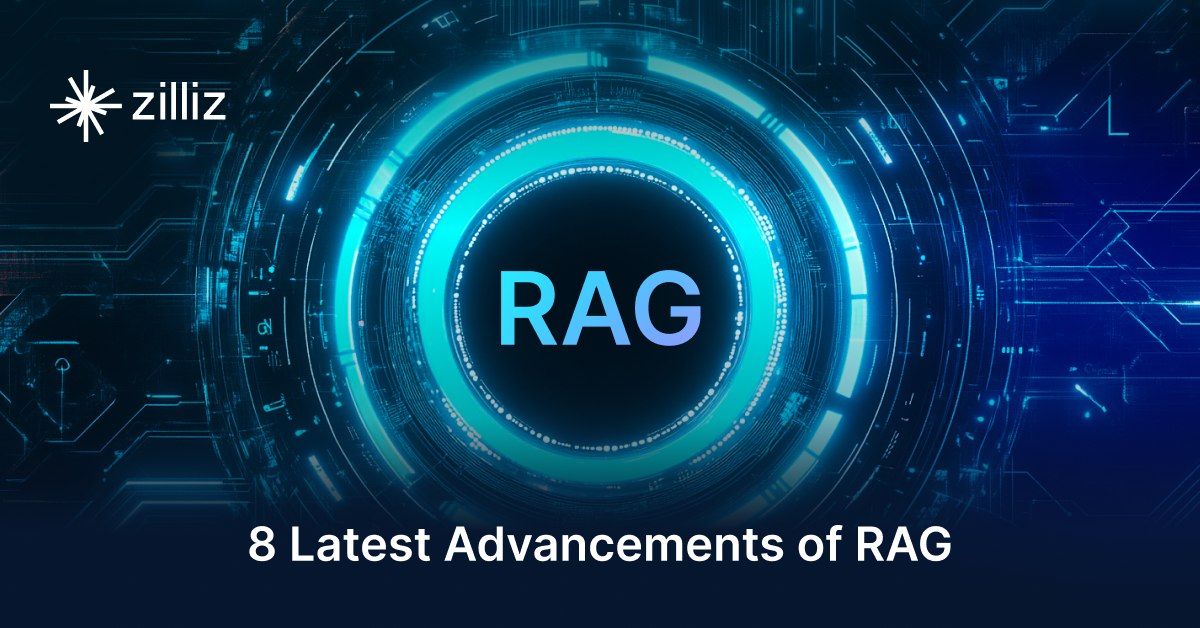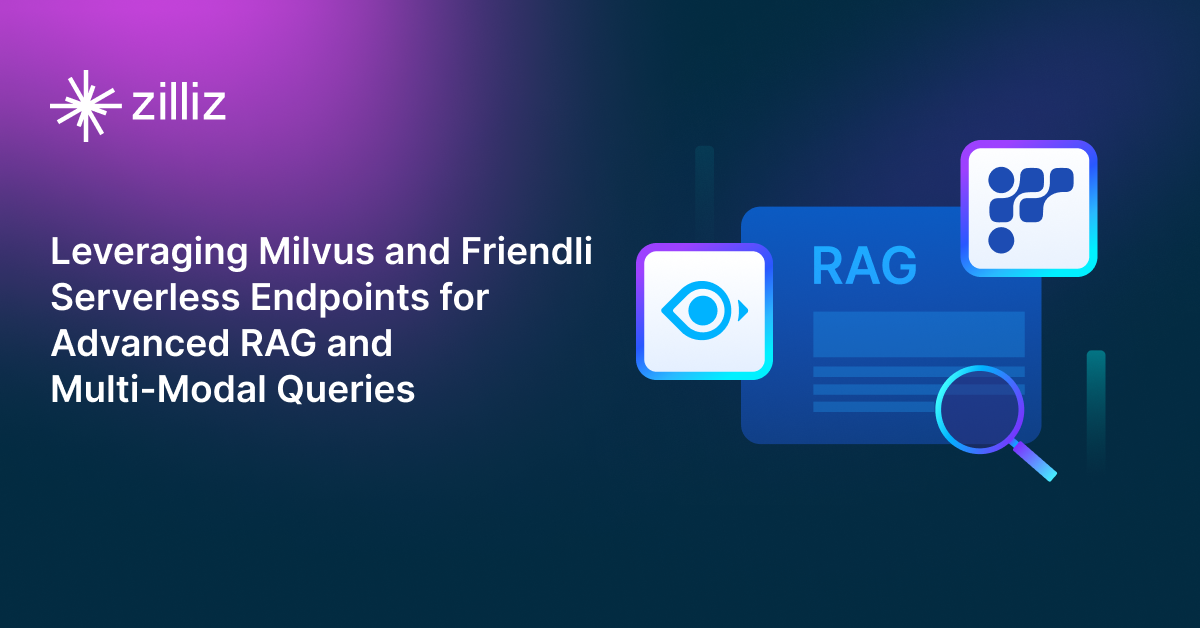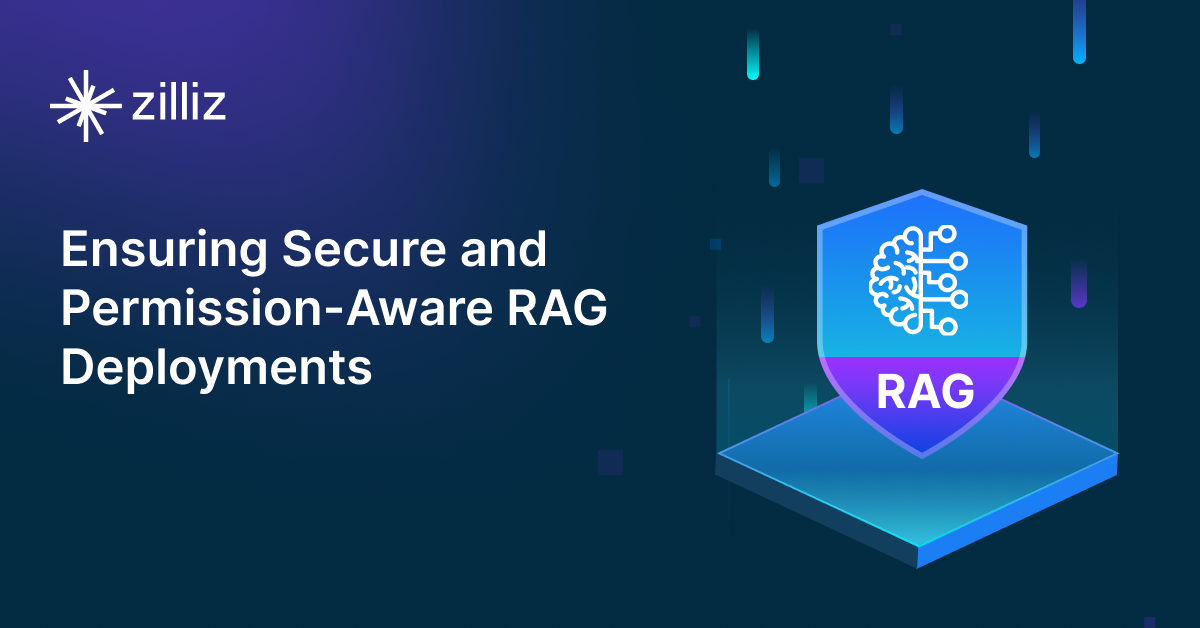Build RAG Chatbot with Haystack, Milvus, OpenAI GPT-4o mini, and HuggingFace all-MiniLM-L12-v1
Introduction to RAG
Retrieval-Augmented Generation (RAG) is a game-changer for GenAI applications, especially in conversational AI. It combines the power of pre-trained large language models (LLMs) like OpenAI’s GPT with external knowledge sources stored in vector databases such as Milvus and Zilliz Cloud, allowing for more accurate, contextually relevant, and up-to-date response generation. A RAG pipeline usually consists of four basic components: a vector database, an embedding model, an LLM, and a framework.
Key Components We'll Use for This RAG Chatbot
This tutorial shows you how to build a simple RAG chatbot in Python using the following components:
- Haystack: An open-source Python framework designed for building production-ready NLP applications, particularly question answering and semantic search systems. Haystack excels at retrieving information from large document collections through its modular architecture that combines retrieval and reader components. Ideal for developers creating search applications, chatbots, and knowledge management systems that require efficient document processing and accurate information extraction from unstructured text.
- Milvus: An open-source vector database optimized to store, index, and search large-scale vector embeddings efficiently, perfect for use cases like RAG, semantic search, and recommender systems. If you hate to manage your own infrastructure, we recommend using Zilliz Cloud, which is a fully managed vector database service built on Milvus and offers a free tier supporting up to 1 million vectors.
- OpenAI GPT-4o mini: A streamlined, cost-efficient variant of GPT-4, optimized for scalable AI applications. It balances high performance with reduced computational demands, offering fast response times and lower costs. Ideal for real-time chatbots, content generation, and integration into resource-constrained environments like mobile apps or high-volume transactional systems.
- HuggingFace all-MiniLM-L12-v1: A compact sentence embedding model designed to convert text into dense vector representations for semantic understanding. It balances speed and efficiency with strong performance in tasks like semantic search, text clustering, and retrieval-augmented generation. Ideal for applications requiring low-latency inference or resource-constrained environments while maintaining robust semantic analysis capabilities.
By the end of this tutorial, you’ll have a functional chatbot capable of answering questions based on a custom knowledge base.
Note: Since we may use proprietary models in our tutorials, make sure you have the required API key beforehand.
Step 1: Install and Set Up Haystack
import os
import requests
from haystack import Pipeline
from haystack.components.converters import MarkdownToDocument
from haystack.components.preprocessors import DocumentSplitter
from haystack.components.writers import DocumentWriter
Step 2: Install and Set Up OpenAI GPT-4o mini
To use OpenAI models, you need to get an OpenAI API key. The Haystack integration with OpenAI models uses an OPENAI_API_KEY environment variable by default. Otherwise, you can pass an API key at initialization with api_key:
generator = OpenAIGenerator(api_key=Secret.from_token("<your-api-key>"), model="gpt-4o-mini")
Then, the generator component needs a prompt to operate, but you can pass any text generation parameters valid for the openai.ChatCompletion.create method directly to this component using the generation_kwargs parameter, both at initialization and to run() method. For more details on the parameters supported by the OpenAI API, refer to the OpenAI documentation.
Now let's install and set up OpenAI models.
from haystack.components.generators import OpenAIGenerator
generator = OpenAIGenerator(model="gpt-4o-mini", api_key=Secret.from_token("<your-api-key>"))
Step 3: Install and Set Up HuggingFace all-MiniLM-L12-v1
Haystack'sHuggingFaceAPITextEmbedder can be used to embed strings with different Hugging Face APIs:
The component uses a HF_API_TOKEN environment variable by default. Otherwise, you can pass a Hugging Face API token at initialization with token – see code examples below. The token is needed:
- If you use the Serverless Inference API, or
- If you use Inference Endpoints.
Here, in this tutorial, we'll use the Free Serverless Inference API. Let's install and set up the model.
To use this API, you need a free Hugging Face token. The Embedder expects the model in api_params.
from haystack.components.embedders import HuggingFaceAPITextEmbedder
from haystack.utils import Secret
from haystack.components.embedders import HuggingFaceAPIDocumentEmbedder
from haystack.dataclasses import Document
text_embedder = HuggingFaceAPITextEmbedder(api_type="serverless_inference_api",
api_params={"model": "sentence-transformers/all-MiniLM-L12-v1"},
token=Secret.from_token("<your-api-key>"))
document_embedder = HuggingFaceAPIDocumentEmbedder(api_type="serverless_inference_api",
api_params={"model": "sentence-transformers/all-MiniLM-L12-v1"},
token=Secret.from_token("<your-api-key>"))
Step 4: Install and Set Up Milvus
pip install --upgrade pymilvus milvus-haystack
from milvus_haystack import MilvusDocumentStore
from milvus_haystack.milvus_embedding_retriever import MilvusEmbeddingRetriever
document_store = MilvusDocumentStore(connection_args={"uri": "./milvus.db"}, drop_old=True,)
retriever = MilvusEmbeddingRetriever(document_store=document_store, top_k=3)
Step 5: Build a RAG Chatbot
Now that you’ve set up all components, let’s start to build a simple chatbot. We’ll use the Milvus introduction doc as a private knowledge base. You can replace it your own dataset to customize your RAG chatbot.
url = 'https://raw.githubusercontent.com/milvus-io/milvus-docs/refs/heads/v2.5.x/site/en/about/overview.md'
example_file = 'example_file.md'
response = requests.get(url)
with open(example_file, 'wb') as f:
f.write(response.content)
file_paths = [example_file] # You can replace it with your own file paths.
indexing_pipeline = Pipeline()
indexing_pipeline.add_component("converter", MarkdownToDocument())
indexing_pipeline.add_component("splitter", DocumentSplitter(split_by="sentence", split_length=2))
indexing_pipeline.add_component("embedder", document_embedder)
indexing_pipeline.add_component("writer", DocumentWriter(document_store))
indexing_pipeline.connect("converter", "splitter")
indexing_pipeline.connect("splitter", "embedder")
indexing_pipeline.connect("embedder", "writer")
indexing_pipeline.run({"converter": {"sources": file_paths}})
# print("Number of documents:", document_store.count_documents())
question = "What is Milvus?" # You can replace it with your own question.
retrieval_pipeline = Pipeline()
retrieval_pipeline.add_component("embedder", text_embedder)
retrieval_pipeline.add_component("retriever", retriever)
retrieval_pipeline.connect("embedder", "retriever")
retrieval_results = retrieval_pipeline.run({"embedder": {"text": question}})
# for doc in retrieval_results["retriever"]["documents"]:
# print(doc.content)
# print("-" * 10)
from haystack.utils import Secret
from haystack.components.builders import PromptBuilder
retriever = MilvusEmbeddingRetriever(document_store=document_store, top_k=3)
text_embedder = HuggingFaceAPITextEmbedder(api_type="serverless_inference_api",
api_params={"model": "sentence-transformers/all-MiniLM-L12-v1"},
token=Secret.from_token("<your-api-key>"))
prompt_template = """Answer the following query based on the provided context. If the context does
not include an answer, reply with 'I don't know'.\n
Query: {{query}}
Documents:
{% for doc in documents %}
{{ doc.content }}
{% endfor %}
Answer:
"""
rag_pipeline = Pipeline()
rag_pipeline.add_component("text_embedder", text_embedder)
rag_pipeline.add_component("retriever", retriever)
rag_pipeline.add_component("prompt_builder", PromptBuilder(template=prompt_template))
rag_pipeline.add_component("generator", generator)
rag_pipeline.connect("text_embedder.embedding", "retriever.query_embedding")
rag_pipeline.connect("retriever.documents", "prompt_builder.documents")
rag_pipeline.connect("prompt_builder", "generator")
results = rag_pipeline.run({"text_embedder": {"text": question}, "prompt_builder": {"query": question},})
print('RAG answer:\n', results["generator"]["replies"][0])
Optimization Tips
As you build your RAG system, optimization is key to ensuring peak performance and efficiency. While setting up the components is an essential first step, fine-tuning each one will help you create a solution that works even better and scales seamlessly. In this section, we’ll share some practical tips for optimizing all these components, giving you the edge to build smarter, faster, and more responsive RAG applications.
Haystack optimization tips
To optimize Haystack in a RAG setup, ensure you use an efficient retriever like FAISS or Milvus for scalable and fast similarity searches. Fine-tune your document store settings, such as indexing strategies and storage backends, to balance speed and accuracy. Use batch processing for embedding generation to reduce latency and optimize API calls. Leverage Haystack's pipeline caching to avoid redundant computations, especially for frequently queried documents. Tune your reader model by selecting a lightweight yet accurate transformer-based model like DistilBERT to speed up response times. Implement query rewriting or filtering techniques to enhance retrieval quality, ensuring the most relevant documents are retrieved for generation. Finally, monitor system performance with Haystack’s built-in evaluation tools to iteratively refine your setup based on real-world query performance.
Milvus optimization tips
Milvus serves as a highly efficient vector database, critical for retrieval tasks in a RAG system. To optimize its performance, ensure that indexes are properly built to balance speed and accuracy; consider utilizing HNSW (Hierarchical Navigable Small World) for efficient nearest neighbor search where response time is crucial. Partitioning data based on usage patterns can enhance query performance and reduce load times, enabling better scalability. Regularly monitor and adjust cache settings based on query frequency to avoid latency during data retrieval. Employ batch processing for vector insertions, which can minimize database lock contention and enhance overall throughput. Additionally, fine-tune the model parameters by experimenting with the dimensionality of the vectors; higher dimensions can improve retrieval accuracy but may increase search time, necessitating a balance tailored to your specific use case and hardware infrastructure.
OpenAI GPT-4o Mini optimization tips
To optimize the OpenAI GPT-4o Mini in a RAG setup, ensure concise input formatting by truncating or summarizing retrieved documents to stay within token limits. Use precise query phrasing to improve retrieval relevance, and filter redundant context to reduce noise. Leverage temperature and max_tokens parameters to balance creativity and focus. Cache frequent queries to minimize API calls and latency. Regularly validate outputs against ground truth to refine prompts and retrieval logic. Prioritize structured templates for consistent responses and implement error handling for rate limits or timeouts.
HuggingFace all-MiniLM-L12-v1 optimization tips
To optimize the all-MiniLM-L12-v1 model in a RAG setup: preprocess input data by cleaning and normalizing text (lowercasing, removing special characters) to improve embedding quality. Use batch inference for embedding generation to maximize GPU utilization. Fine-tune the model on domain-specific data via contrastive learning to enhance retrieval relevance. Reduce vector dimensionality via PCA if storage or latency is critical. Cache frequently accessed embeddings to minimize recomputation. Quantize the model with Hugging Face’s transformers library for faster inference with minimal accuracy loss. Regularly benchmark performance against your retrieval metrics (e.g., recall@k) to validate optimizations.
By implementing these tips across your components, you'll be able to enhance the performance and functionality of your RAG system, ensuring it’s optimized for both speed and accuracy. Keep testing, iterating, and refining your setup to stay ahead in the ever-evolving world of AI development.
RAG Cost Calculator: A Free Tool to Calculate Your Cost in Seconds
Estimating the cost of a Retrieval-Augmented Generation (RAG) pipeline involves analyzing expenses across vector storage, compute resources, and API usage. Key cost drivers include vector database queries, embedding generation, and LLM inference.
RAG Cost Calculator is a free tool that quickly estimates the cost of building a RAG pipeline, including chunking, embedding, vector storage/search, and LLM generation. It also helps you identify cost-saving opportunities and achieve up to 10x cost reduction on vector databases with the serverless option.
 Calculate your RAG cost
Calculate your RAG cost
What Have You Learned?
By diving into this tutorial, you’ve unlocked the power of combining cutting-edge tools to build a fully functional RAG system! You learned how Haystack acts as the backbone framework, seamlessly orchestrating the flow of data between components while keeping your pipeline organized and scalable. Milvus, your vector database superhero, stepped in to handle lightning-fast storage and retrieval of embeddings generated by Hugging Face’s all-MiniLM-L12-v1—a compact yet mighty model that transforms text into rich numerical representations. Then, OpenAI’s GPT-4o mini took center stage, using those retrieved context snippets to craft coherent, context-aware responses, proving that even smaller LLMs can deliver big results when paired with the right data. Along the way, you saw how tweaks like optimizing chunk sizes or adjusting similarity thresholds in Milvus can supercharge performance, and you even got a sneak peek at tools like the free RAG cost calculator to keep your projects budget-friendly.
Now, you’re equipped with the know-how to turn raw data into intelligent, responsive applications—whether that’s chatbots, search engines, or creative AI tools. The magic of RAG isn’t just in the tech stack; it’s in how you adapt it to solve real-world problems. So go ahead—experiment, iterate, and let your creativity run wild! Tinker with different embedding models, fine-tune your retrieval strategies, or explore hybrid search approaches. The future of AI-powered solutions is in your hands, and every line of code you write brings you closer to building something groundbreaking. Ready to make waves? Start building, optimize fearlessly, and watch your ideas come to life! 🚀
Further Resources
🌟 In addition to this RAG tutorial, unleash your full potential with these incredible resources to level up your RAG skills.
- How to Build a Multimodal RAG | Documentation
- How to Enhance the Performance of Your RAG Pipeline
- Graph RAG with Milvus | Documentation
- How to Evaluate RAG Applications - Zilliz Learn
- Generative AI Resource Hub | Zilliz
We'd Love to Hear What You Think!
We’d love to hear your thoughts! 🌟 Leave your questions or comments below or join our vibrant Milvus Discord community to share your experiences, ask questions, or connect with thousands of AI enthusiasts. Your journey matters to us!
If you like this tutorial, show your support by giving our Milvus GitHub repo a star ⭐—it means the world to us and inspires us to keep creating! 💖
- Introduction to RAG
- Key Components We'll Use for This RAG Chatbot
- Step 1: Install and Set Up Haystack
- Step 2: Install and Set Up OpenAI GPT-4o mini
- Step 3: Install and Set Up HuggingFace all-MiniLM-L12-v1
- Step 4: Install and Set Up Milvus
- Step 5: Build a RAG Chatbot
- Optimization Tips
- RAG Cost Calculator: A Free Tool to Calculate Your Cost in Seconds
- What Have You Learned?
- Further Resources
- We'd Love to Hear What You Think!
Content
Vector Database at Scale
Zilliz Cloud is a fully-managed vector database built for scale, perfect for your RAG apps.
Try Zilliz Cloud for Free


